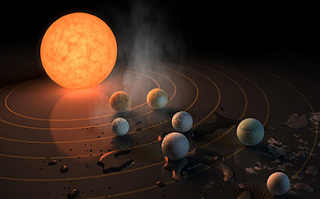Seven Earth-like exoplanets orbit nearby star
The largest known system of Earth-like exoplanets has been found orbiting a dwarf star in the Milky Way. At least three of the seven rocky exoplanets could have oceans of water, making it possible that the system could harbour life. The discovery lends weight to the growing belief among some astronomers that our galaxy could be teeming with Earth-like worlds.
The first exoplanet – a planet orbiting a star other than the Sun – was discovered 25 years ago, and since then, astronomers have identified thousands of such objects. Most are Jupiter-like gas giants because huge exoplanets are much easier to detect than smaller Earth-like worlds. However, improved techniques and new telescopes have led to the discovery of Earth-like exoplanets with the potential to harbour life.
In 2010, an international team of astronomers began using the TRAPPIST telescope in Chile to search for Earth-like exoplanets orbiting small stars nearby in the Milky Way. They were looking for tiny drops in the intensity of a star that occur when an exoplanet's orbit takes it between the star and Earth. Such "transits" of small exoplanets are much easier to see with dwarf stars because the change in intensity is large.
Rocky compositions
Just 40 light-years from Earth, they spotted a star they called TRAPPIST-1 that appeared to be transited by several exoplanets. Now, further observations – including 20 days of continuous monitoring using NASA's Spitzer Space Telescope – have revealed seven exoplanets in the TRAPPIST-1 system. The exoplanets have orbital periods ranging from 1.5–20 days. All seven objects appear to be similar in size to Earth, with radii ranging from 0.77–1.13 Earth radii. The team was able to determine the mass and density of six of the exoplanets, which suggests that they have rocky compositions.TRAPPIST-1 is about 80 times more massive than Jupiter. So instead of resembling the Sun and its planets, the system is similar to Jupiter and its four Galilean moons – according to team member Michaël Gillon of the University of Liege in Belgium. Gillon says that three of the planets orbit within the habitable zone of the star, which means that they could have liquid water and even life.
TRAPPIST-1's nearness to Earth combined with the fact that the exoplanets are relatively large compared with the star means that it should be possible to study the exoplanet atmospheres. This would provide important information about chemical composition and the possibility of life.
Climate studies
According to Amaury Triaud of the University of Cambridge in the UK, the team is now trying to work out if the exoplanets are shrouded in envelopes of hydrogen – which would suggest that they are not Earth-like. The James Webb Space Telescope – to be launched in 2018 – will have the capability to study the composition of the exoplanet's atmospheres and even their climates. "We could know if there is life in TRAPPIST-1 within a decade," says Triaud.TRAPPIST-1 is described in Nature. Hear Sara Seager explain how astronomers are searching for life on exoplanets in this podcast: Searching for life on other planets.
Labels: SCIENCE


0 Comments:
Post a Comment
Subscribe to Post Comments [Atom]
<< Home